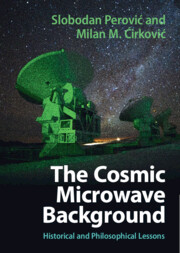Book contents
- The Cosmic Microwave Background
- The Cosmic Microwave Background
- Copyright page
- Epigraph
- Contents
- Acknowledgments
- Introduction
- Part I Physical cosmology: A brief introduction
- Part II Discovery of the CMB and current cosmological orthodoxy
- Part III What constitutes an unorthodoxy? An epistemological framework of cosmology
- Part IV Moderate unorthodoxies: The CMB with the Big Bang
- 11 Cold and Tepid Big Bangs
- 12 Models with unresolved sources
- 13 Thermalization by grains, the first wave
- 14 Primordial chaos
- 15 Early intergalactic medium, massive Population III objects, and the large-numbers hypothesis
- 16 Late thermalization of starlight
- 17 “An excess in moderation”
- Part V Radical unorthodoxies: The CMB without the Big Bang
- Part VI Formation of the orthodoxy and the alternatives: Epistemological lessons
- Part VII Other philosophically relevant aspects of the CMB
- Book part
- Notes
- References
- Index
11 - Cold and Tepid Big Bangs
Population III objects
from Part IV - Moderate unorthodoxies: The CMB with the Big Bang
Published online by Cambridge University Press: aN Invalid Date NaN
- The Cosmic Microwave Background
- The Cosmic Microwave Background
- Copyright page
- Epigraph
- Contents
- Acknowledgments
- Introduction
- Part I Physical cosmology: A brief introduction
- Part II Discovery of the CMB and current cosmological orthodoxy
- Part III What constitutes an unorthodoxy? An epistemological framework of cosmology
- Part IV Moderate unorthodoxies: The CMB with the Big Bang
- 11 Cold and Tepid Big Bangs
- 12 Models with unresolved sources
- 13 Thermalization by grains, the first wave
- 14 Primordial chaos
- 15 Early intergalactic medium, massive Population III objects, and the large-numbers hypothesis
- 16 Late thermalization of starlight
- 17 “An excess in moderation”
- Part V Radical unorthodoxies: The CMB without the Big Bang
- Part VI Formation of the orthodoxy and the alternatives: Epistemological lessons
- Part VII Other philosophically relevant aspects of the CMB
- Book part
- Notes
- References
- Index
Summary
Although developed within the relativistic framework, the cold and tepid Big Bang models were prime examples of moderate unorthodoxy that introduced alternative, very different initial conditions (i.e., photon to baryon ratio). As the chapter explains, they provided more plausible and “easier” conditions for the structure formation in the early universe, but they differed in terms of their theoretic, epistemic, and methodological motivations. Misner reversed-engineered the universe to more favorable initial conditions, Alfvén’s toy-model was motivated by the ad hoc nature of the Hot Big Bang model, and Carr and Reese emphasized the necessity of the early fluctuations the orthodoxy lacked in order to explain inhomogeneity in the current universe and the implausibility of cosmological entropy. The respective explanations of the CMB within these models relied in various ways on the so-called Population III objects’ radiation, a set of objects that formed fairly soon after the Big Bang. These non-cosmological explanations were partly motivated by the 1978 measurements that erroneously indicated lack of agreement with the black body spectrum shape, and they ran into real difficulties only with the COBE satellite data. The chapter contains a box with a technical explanation of the minimal comptonization parameter describing a redistribution of photons in reference to the black body spectrum.
Keywords
- Type
- Chapter
- Information
- The Cosmic Microwave BackgroundHistorical and Philosophical Lessons, pp. 63 - 72Publisher: Cambridge University PressPrint publication year: 2024



